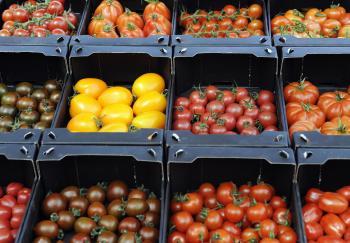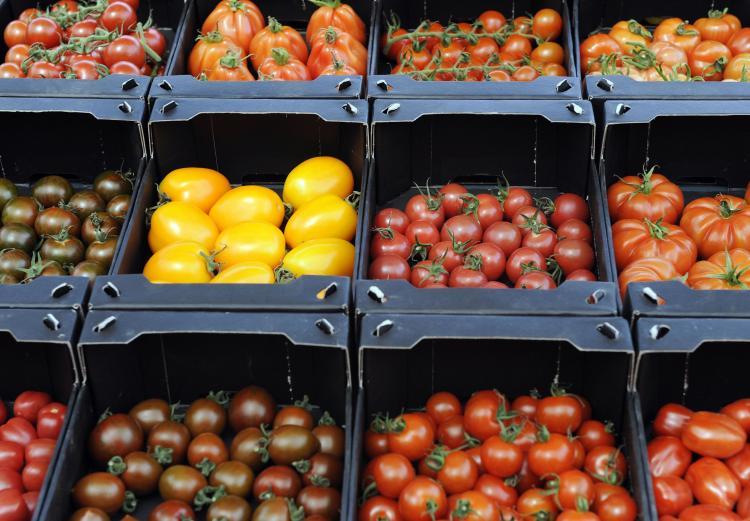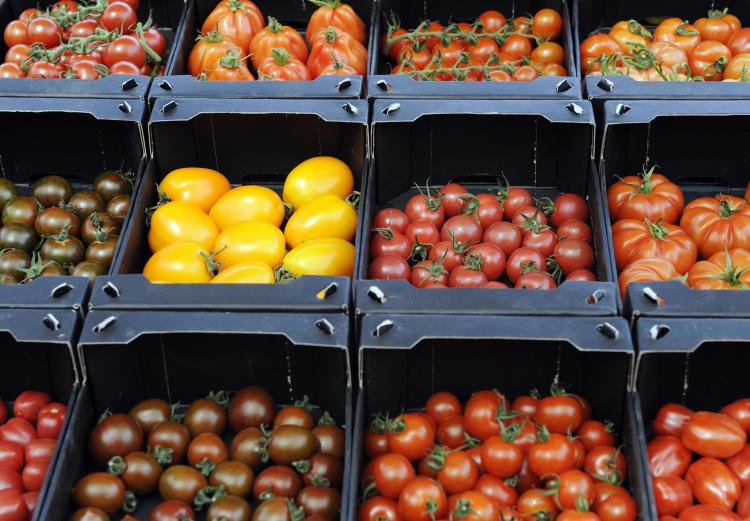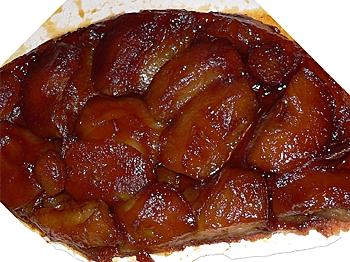Tomatoes come in a variety of colors, shapes, and sizes: Large red beefsteaks are slightly irregular; globes are red, medium-size and round; plum tomatoes are egg-shaped and red or yellow; and cherry tomatoes are small and round. There are also many heirloom varieties that are not marketed widely but come in red, yellow, green, purple, or even striped.
Tomatoes are available year-round, but are usually at their peak from June to September. The most flavorful are ripened on the vine, not in stores where most are sold. Choose firm tomatoes, richly colored, and noticeably fragrant. Ripe tomatoes should be stored at room temperature and used within a few days. Tomatoes should not be refrigerated, as cold temperature kills the flavor and turns the flesh grainy. This versatile fruit goes well with: anchovies, arugula, basil, bread crumbs, cheese, chiles, chives, cucumbers, eggs, garlic, lemon, marjoram, mint, mushrooms, olive oil, olives, onions, oregano, parsley, pasta, pepper, peppers, saffron, salt, seafood, shallots, sugar, tarragon, thyme, and vinegar.
The earliest mention of the tomato in European literature is found in an herbal written by Matthiolus in 1544. He described tomatoes, or as they were called in Italy, pomi d'oro (golden apple), and wrote that they were “eaten in Italy with oil, salt, and pepper.” This provides evidence that the first tomatoes to reach the Old World were probably a yellow variety, and that they were introduced via the Mediterranean.
The Aztecs of Central America called it “xitomatl,” and Central American tribes called it “tomati.” Aztec writings in Central America mention dishes of peppers, salt, and tomatoes, a concoction likely an original salsa recipe.
After the Spanish colonization of the Americas, the Spanish apparently distributed the tomato throughout their colonies in the Caribbean. They also took it to the Philippines, whence it moved to southeast Asia and then the entire Asian continent. The Spanish also brought the tomato to Europe. It grew easily in Mediterranean climates and cultivation began in the 1540s. The earliest discovered cookbook with tomato recipes was published in Naples in 1692. The pome dei Moro (Moor’s apple), was probably among the first cultivated tomato variety. Cultivation of several varieties became widespread in the ensuing decades in Spain, Italy, and in France, where it was called pomme d'amour (love apple) likely the result of a corruption of the early Spanish name, pome dei Moro.
As it moved north, it encountered more resistance. Like potatoes and eggplants, tomatoes are members of the nightshade family. Deadly nightshade, atropus belladonna, bears a striking resemblance to a tomato plant. Deadly nightshade is a poisonous plant that has been used as both a hallucinogenic drug and a beauty aid in different parts of Europe. The Latin name “belladonna” literally means beautiful lady. Ladies in medieval courts would apply a few drops of nightshade extract to their eyes to dilate their pupils, a look considered fashionable at the time. Tomatoes translated from the common German name as “wolf peach,” was avoided for obvious reasons. The British admired the tomato for its beauty, but believed that it was poisonous (tomato leaves and stems contain poisonous glycoalkaloids, but the fruit is safe). The tomato was thus considered unfit for eating, though not necessarily poisonous, for many years in Britain and its North American colonies. By the mid-1700s, tomatoes were widely eaten in Britain; and before the end of that century, the Encyclopedia Britannica stated that the tomato was “in daily use” in soups, broths, and as a garnish. In Victorian times, cultivation reached an industrial scale in glasshouses, most famously in the seaside town of Worthing.
One of the first cookbooks to mention tomatoes was published in Naples in 1692. By 1700, seven types are mentioned in one article, including a large red type. In the 1700s, English cooks used tomatoes sparingly in the flavoring of soups. Earliest records of marketing tomatoes are from the early 1800s in Europe. Pressure for housing land in the 1930s to 1960s saw the British industry move west to Littlehampton and to the market gardens south of Chichester. Over the past few years, the British tomato industry has declined as more competitive imports from Spain and the Netherlands have reached supermarkets.
Is the tomato a fruit or vegetable? The answer depends on whom you ask. Technically, they are berries. By definition, a fruit is the edible plant structure of a mature ovary of a flowering plant, usually eaten raw. Some are sweet like apples, but the ones that are not sweet such as tomatoes, cucumbers, and peppers are commonly called vegetables. Until the late 1800s the tomato was classified as a fruit to avoid taxation, but this was changed after a Supreme Court ruling that the tomato is a vegetable and should be taxed accordingly.
Tomatoes have become a staple item in kitchens throughout the world. Each area of the world has its own tomato history and how it is used in everyday dining. It appears that tomatoes have had the largest impact on American eating habits. The tomato is the most popular vegetable in America. Americans enjoy over 12 million tons of tomatoes each year.
Tomatoes are available year-round, but are usually at their peak from June to September. The most flavorful are ripened on the vine, not in stores where most are sold. Choose firm tomatoes, richly colored, and noticeably fragrant. Ripe tomatoes should be stored at room temperature and used within a few days. Tomatoes should not be refrigerated, as cold temperature kills the flavor and turns the flesh grainy. This versatile fruit goes well with: anchovies, arugula, basil, bread crumbs, cheese, chiles, chives, cucumbers, eggs, garlic, lemon, marjoram, mint, mushrooms, olive oil, olives, onions, oregano, parsley, pasta, pepper, peppers, saffron, salt, seafood, shallots, sugar, tarragon, thyme, and vinegar.
The earliest mention of the tomato in European literature is found in an herbal written by Matthiolus in 1544. He described tomatoes, or as they were called in Italy, pomi d'oro (golden apple), and wrote that they were “eaten in Italy with oil, salt, and pepper.” This provides evidence that the first tomatoes to reach the Old World were probably a yellow variety, and that they were introduced via the Mediterranean.
The Aztecs of Central America called it “xitomatl,” and Central American tribes called it “tomati.” Aztec writings in Central America mention dishes of peppers, salt, and tomatoes, a concoction likely an original salsa recipe.
After the Spanish colonization of the Americas, the Spanish apparently distributed the tomato throughout their colonies in the Caribbean. They also took it to the Philippines, whence it moved to southeast Asia and then the entire Asian continent. The Spanish also brought the tomato to Europe. It grew easily in Mediterranean climates and cultivation began in the 1540s. The earliest discovered cookbook with tomato recipes was published in Naples in 1692. The pome dei Moro (Moor’s apple), was probably among the first cultivated tomato variety. Cultivation of several varieties became widespread in the ensuing decades in Spain, Italy, and in France, where it was called pomme d'amour (love apple) likely the result of a corruption of the early Spanish name, pome dei Moro.
As it moved north, it encountered more resistance. Like potatoes and eggplants, tomatoes are members of the nightshade family. Deadly nightshade, atropus belladonna, bears a striking resemblance to a tomato plant. Deadly nightshade is a poisonous plant that has been used as both a hallucinogenic drug and a beauty aid in different parts of Europe. The Latin name “belladonna” literally means beautiful lady. Ladies in medieval courts would apply a few drops of nightshade extract to their eyes to dilate their pupils, a look considered fashionable at the time. Tomatoes translated from the common German name as “wolf peach,” was avoided for obvious reasons. The British admired the tomato for its beauty, but believed that it was poisonous (tomato leaves and stems contain poisonous glycoalkaloids, but the fruit is safe). The tomato was thus considered unfit for eating, though not necessarily poisonous, for many years in Britain and its North American colonies. By the mid-1700s, tomatoes were widely eaten in Britain; and before the end of that century, the Encyclopedia Britannica stated that the tomato was “in daily use” in soups, broths, and as a garnish. In Victorian times, cultivation reached an industrial scale in glasshouses, most famously in the seaside town of Worthing.
One of the first cookbooks to mention tomatoes was published in Naples in 1692. By 1700, seven types are mentioned in one article, including a large red type. In the 1700s, English cooks used tomatoes sparingly in the flavoring of soups. Earliest records of marketing tomatoes are from the early 1800s in Europe. Pressure for housing land in the 1930s to 1960s saw the British industry move west to Littlehampton and to the market gardens south of Chichester. Over the past few years, the British tomato industry has declined as more competitive imports from Spain and the Netherlands have reached supermarkets.
Is the tomato a fruit or vegetable? The answer depends on whom you ask. Technically, they are berries. By definition, a fruit is the edible plant structure of a mature ovary of a flowering plant, usually eaten raw. Some are sweet like apples, but the ones that are not sweet such as tomatoes, cucumbers, and peppers are commonly called vegetables. Until the late 1800s the tomato was classified as a fruit to avoid taxation, but this was changed after a Supreme Court ruling that the tomato is a vegetable and should be taxed accordingly.
Tomatoes have become a staple item in kitchens throughout the world. Each area of the world has its own tomato history and how it is used in everyday dining. It appears that tomatoes have had the largest impact on American eating habits. The tomato is the most popular vegetable in America. Americans enjoy over 12 million tons of tomatoes each year.






